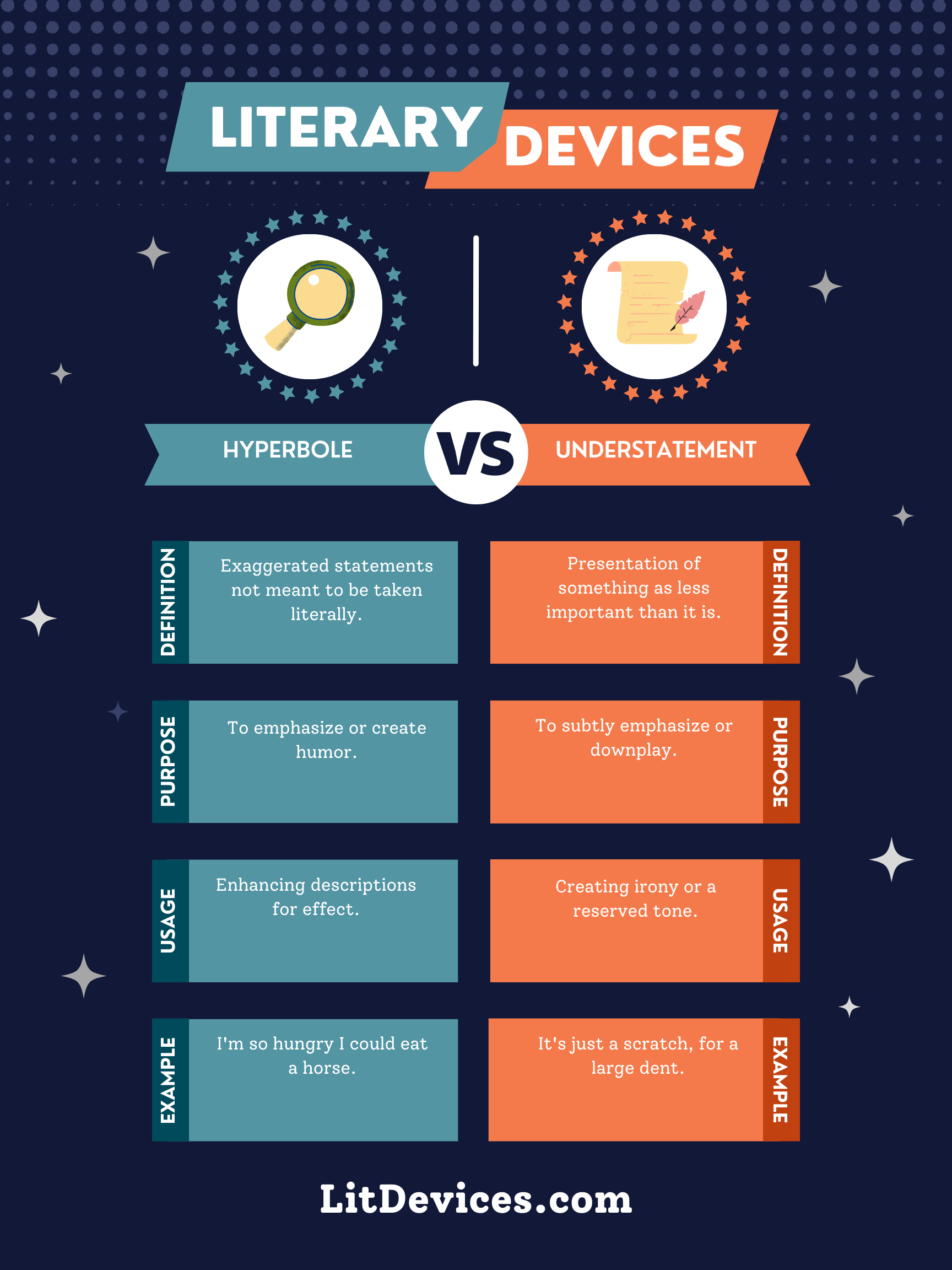Hyperbole is an extreme exaggeration used for emphasis; Understatement makes a situation seem less important or serious than it is.
Hyperbole
Hyperbole is a figure of speech that involves an exaggeration of ideas for the sake of emphasis. It’s not meant to be taken literally but is used to create a strong impression and add dramatic effect.
🚀 Example: “I’m so hungry I could eat a horse.” This doesn’t literally mean one would eat a horse but rather that they are very hungry.
Understatement
Understatement is a literary device that makes a situation seem less important or serious than it actually is. It’s often used for comedic effect or to subtly highlight the gravity of a situation through contrast.
🌱 Example: Saying “It’s just a scratch” when referring to a large dent on a car. This minimizes the actual extent of the damage.
Summary
| Literary Device | Definition | Purpose | Usage | Relevant Examples |
|---|---|---|---|---|
| Hyperbole | An extreme exaggeration used for emphasis or dramatic effect. | To create a strong impression, add humor, or emphasize a point dramatically. | Used in both casual conversation and formal writing, including poetry and prose. | “I have a million things to do.” |
| Understatement | A figure of speech that makes a situation seem less important than it really is. | To subtly highlight the gravity of a situation, add ironic humor, or convey modesty. | Common in British humor, formal speeches, and literature to convey subtlety. | “The Titanic had a bit of a problem.” |
Writing Tips
When incorporating hyperbole or understatement into your writing:
- For Hyperbole: Use hyperbole to inject energy and emotion into your writing. It works well in dialogue, descriptions, and to convey characters’ intense feelings or reactions. Be mindful not to overuse it, as that can dilute its impact.
- For Understatement: Employ understatement to add a layer of irony or to subtly convey the seriousness of a situation. It’s particularly effective in creating a dry or witty tone. Understatement can also be a powerful tool in revealing character traits, such as stoicism or humility.
🖋 Example for Hyperbole: Describing a particularly chaotic scene, you might say, “The place was as busy as Grand Central Station on the eve of Thanksgiving.”
🖋 Example for Understatement: In describing an overwhelming disaster, you might underplay the scenario with, “Well, that didn’t go as planned,” to emphasize the enormity of the situation through contrast.
FAQs
Can hyperbole and understatement be used together?
Yes, combining both can create a dynamic contrast in your writing, enhancing the comedic or dramatic effect of a situation.
How do I know when to use hyperbole vs understatement?
Consider your desired effect and audience reaction. Use hyperbole to magnify and underscore, and understatement to subtly draw attention to or underplay a detail.
Are hyperbole and understatement suitable for all types of writing?
While versatile, the effectiveness of these devices depends on the context and tone of your work. Hyperbole fits well in creative writing and persuasive texts, whereas understatement may be more suited to subtle humor or to contrast a serious tone.
Exercise
Identify whether the following sentences employ hyperbole or understatement:
- After a day of mild rain: “We’re experiencing a bit of a moist day, aren’t we?”
- “I could sleep for a year after this week.”
- “Winning the lottery would be kind of nice.”
- “This book was slightly less enjoyable than a root canal.”
Answers:
- Understatement
- Hyperbole
- Understatement
- Understatement (with a touch of irony)
Interesting Literary Device Comparisons
- Metaphor vs. Simile: Both compare two unlike things, but similes use “like” or “as” to make the comparison explicit, whereas metaphors do so directly without these words.
- Irony vs. Sarcasm: Irony involves saying something that implies the opposite for humorous or emphatic effect, while sarcasm is a form of irony that’s particularly biting and often aimed at mocking or ridiculing.
- Alliteration vs. Assonance: Alliteration repeats consonant sounds at the beginnings of words close together, while assonance repeats vowel sounds within words, enhancing the musical quality of the language.

